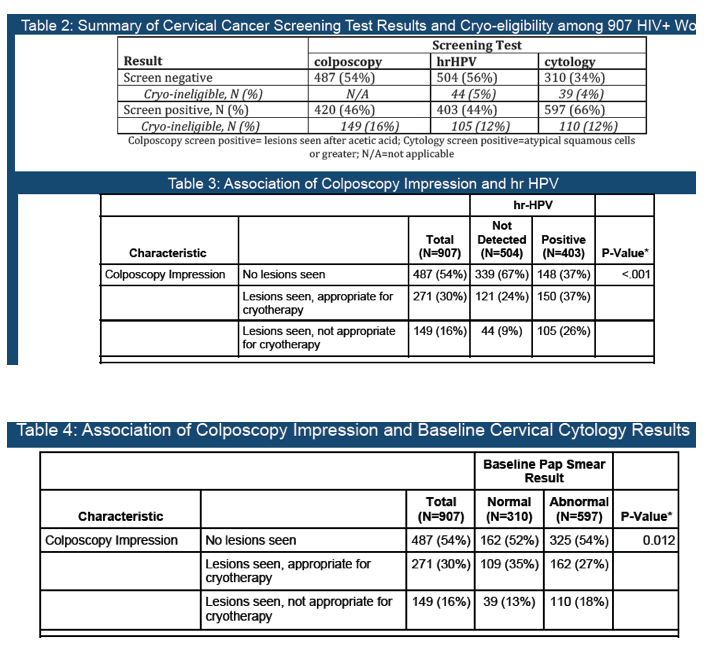 |
 |
 |
| |
Factors Associated with extensive Cervical Lesions among HIV-infected Women Screening for ACTG Protocal A5282
|
| |
| |

Timothy Wilkin1, Roy Matining2, Vikrant Sahasrabuddhe3, Catherine Godfrey4, Thandie Lungu5, Mulindi Mwanahamuntu6, Ramesh Bhosale7, Scott Evans2, Robert W. Coombs8, Cynthia Firnhaber9
1Weill Cornell Med. Coll., New York, NY. 2Harvard T. H. Chan Sch. of Public Health, Ctr for Biostatistics in AIDS Research, Boston, MA. 3National Cancer Institute, Bethesda, MD. 4NIAID, NIH, Bethesda, MD. 5UNC Project, Lilongwe, Malawi.
6Univ. Teaching Hosp., Lusaka, Zambia. 7Byramjee Jeejeebhoy Medical Coll., Pune, India. 8Univ. of Washington, Seattle, WA. 9Univ. of Witswatersand, Johannesburg, South Africa.


program abstract
Background: 'Screen-and-treat' approaches for prevention of cervical cancer are used in many resource-constrained settings because of the challenges associated with cytology. Women are screened with: (1) visual inspection after acetic acid (VIA), or (2) testing for high-risk human papillomavirus (hrHPV), followed by treatment with cervical cryotherapy for those screening positive. However, women may have extensive cryotherapy-ineligible lesions that require excisional procedures. We explored factors associated with these lesions to inform broad implementation of screen and treat programs.
Methods: Cross-sectional study of HIV-infected women screening for A5282, a randomized clinical trial comparing the HPV screen and treat approach to a cytology-based strategy for prevention of cervical cancer. Participants were screened with colposcopy (visual inspection after acetic acid wash using magnification without biopsy), HPV testing (Abbottš hrHPV PCR assay), and cytology. Colposcopy results were categorized as no lesions, cryo-eligible lesions, and cryo-ineligible lesions according to WHO criteria. Participating sites included 8 in sub-Saharan Africa, 2 in India, 1 in Haiti, and 1 in Peru. Fisher's exact test was used to test for association.
Results: 907 women who screened for A5282 had complete colposcopy, hrHPV, and cytology results. The median age (years) was 37 [IQR 32, 42]; median CD4 (cells/mm3) was 524 [IQR 386, 712]; 70% has plasma HIV-1 RNA PP=0.024).
Conclusions: Extensive cervical lesions that are not eligible for treatment with cryotherapy are relatively common (~1 in 6) among HIV-infected women and are not associated with immune suppression or lack of virological control. Adequate treatment for these lesions, such as loop electrosurgical excision procedure, should be readily available within 'screen-and-treat' implementation programs. Further studies are needed to define the optimal management of these lesions.





|
| |
|
 |
 |
|
|